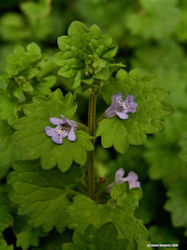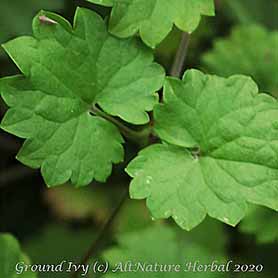Ground Ivy Herb Use, A Beneficial Nuisance?

Authors Karen Bergeron and Deb Jackson
(c) 2000 Updated July 20, 2020
Glechoma hederacea
Other Names: Ale-hoof, Cat's foot, Creeping Charlie, Gill-over-the-ground, Gillrun, Hay maids, hedge maids
Ground Ivy gets little respect from those who prefer to keep a neat lawn and don’t know of its many reputed health benefits. Although it is invasive, Ground Ivy may serve as a ground cover in places where the grass doesn’t grow well, or at tree bases that are difficult to mow. I think it is an attractive plant to have in some places, but it's not something I want in my vegetable garden.
Ground ivy has a long history of use as a medicinal plant, and as an edible herb, dating back to the first century A.D. It was long considered a panacea (cure-all). Also known as Creeping Charlie, it is known for its high vitamin C content, it is said to be one of the first herb and edible plants, along with Plantain, brought to the North American continent by early settlers.
If you feel like you must remove Ground Ivy., you can use the plant material afterwards as a bath soak herb to relieve your sore muscles. Ground Ivy is used in Italian spas as a bath soak for back pain, as well as its emollient and mild sedative properties. My preferred method is to boil a an of water, remove from heat then add a cup or two, or more if you wish, of Ground ivy and let it steep for 15 minutes. You can then strain the Ground Ivy herb from the brew and add it to your bathwater for your own Italian Spa treatment. You can add bath salts or scented oils to make it even more relaxing.
Ground ivy is said to be an excellent spring tonic, for which it is used as an infusion (like tea).. Ground Ivy contains a volatile oil which aids in relieving congestion and inflammation of mucous membranes associated with colds, flu, and sinusitis. The leaves and flowers of Ground Ivy can be dried for tea, made into a tincture, and used externally in a salve or liniment. An infusion of the above-ground plant is said by Lee Peterson, of Peterson’s Guides, “to make a fine tea.” It is supposed to be helpful for colds and lung ailments.
Herbalist Henriette Kress of Finland says of Ground Ivy infusion, “It's one of the few herbs that can touch noise-induced tinnitus…. I know because quite a few told me. It's 2-3 cups of tea for weeks or months on end, or until the noise stops. (... what a relief!)”
The fresh juice of Ground Ivy or a herbal tea of same is used to treat digestive disorders, gastritis, acid indigestion, and diarrhea. It may also be beneficial for liver and kidney function, said to relieve gravel and stones.
A 1986 study found that Ground Ivy’s ursolic and oleanolic acids protected mouse skin from induced tumor growth. It can also be used to lighten skin and fade age spots. For this, I would make a cleansing oil by infusing oil with the dried Ground Ivy herb for a few weeks, then strain. This oil can be used to make a balm or salve if you like. You could tincture it, and apply to trouble spots or mix some tincture with witch hazel distillate for a toner. It could also be used in a soap recipe.
Before lead paint was banned, it was said that painters who drank Ground Ivy tea were not bothered with lead poisoning.
Like most plants with edible leaves, it can be used as a flavoring, a spring green, or addition to soups and stews. In the Middle Ages, Creeping Charlie was known as Ale-Hoof and was added to beer for flavor, to clarify, and add shelf life. It is very high in iron.
Some of the most valuable plant constituents of Ground Ivy are 1,8-cineole, alpha-pinene, apigenin, beta-sitosterol, borneol, caffeic-acid, ferulic-acid, hyperoside, iodine, luteolin, menthol, oleanolic-acid, rosmarinic-acid, rutin, ursolic-acid.
Ground Ivy Habitat and Description

Ground ivy forms masses of small scallop-shaped evergreen leaves that lay low on the ground for most of the year. At flowering time in spring, it grows erect up to 6 inches to show off its dainty purple flowers nestled in the axils of its paired leaves, then returns to its ground-hugging habit.
Ground ivy is a creeping European perennial evergreen, naturalized in North America and found in moist shady areas, along paths, around hedges, and roadsides from Ontario to deep south, west to Kansas, and along the Pacific Coast. A member of the mint family, it is finely haired all over and has a square creeping stem which grows from a few inches up to two feet long. The leaves are heart shaped, opposite, scalloped, and dark green, sometimes tinted purple. The main root is thick and matted. It sends out runners as long as 36 inches. Ground Ivy flowers appear in march and are purplish to blue, two lipped and grow in axillary whorls of six.
How to Grow Ground Ivy
Ground Ivy is easily cultivated through root division and thrives in moist shady areas. As it is considered an invasive weed by many who are not aware of its uses, you may not want to grow it. Ground Ivy is a great herb for wildcrafting, due to its abundance.
How to use Ground Ivy
Gather leaves, flowers and stems of Ground Ivy year round. It can be dried for later herbal use.
Ground Ivy Herb Recipes
Spring Tonic: Steep 2 tsp. of fresh or dried herb in 1 cup water for 10 min. flavor with peppermint or honey to taste take in half cup doses twice a day.
Colds and flu: Express fresh juice with press. Take in 1 tsp. doses 3 times a day, 1/2 tsp. for children. Use 2 or 3 drops in nose twice a day for sinusitis.
Ground Ivy, Creeping Charlie Links
Anti-Melanogenesis Effect of Glechoma hederaceaL. Extract on B16 Murine Melanoma Cell
Ground Ivy Medicinal Properties
Ground Ivy - Henriette’s Herbal,
Article by Deb Jackson & Karen Bergeron (c) AltNature 2000 Updated 05/2/2022



